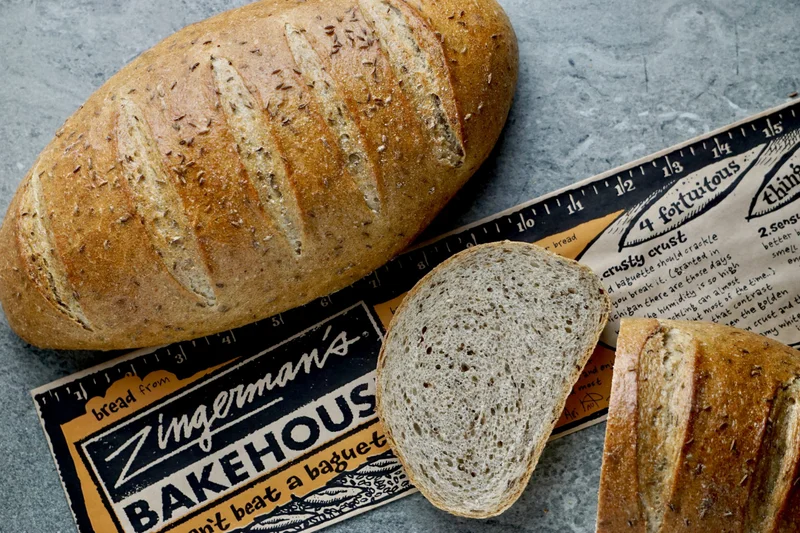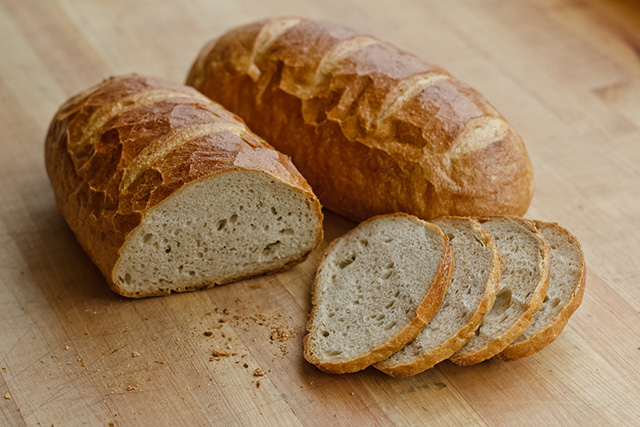Excerpt from Ari’s Top 5 enews
Jewish Rye the way it would have been 100 years ago
 In a previous Ari’s Top 5, I referenced the work of Anzia Yezierska, the late 19th-century Russian Jewish immigrant whose books became some of the best-known representations of the experience of new arrivals in New York’s Lower East Side. Her writing deals with poverty, language issues, cultural shifts, and more. In Yezierska’s 1925 novel The Bread Givers, the main character, who works in a sweatshop and lives in poverty, says, “Whenever I passed a restaurant or a delicatessen store, I couldn’t tear my eyes away from the food in the window. Something wild in me wanted to break through the glass, snatch some of that sausage and corned beef, and gorge myself just once.” Rye bread was a big part of the culinary story; a staple of eating that would have made regular appearances on the tables of nearly every poor European Jewish immigrant family. It was all people could afford. White bread back then was mostly for the wealthy. Later, as immigrants began to gain some modicum of lower-middle-class existence, that started to shift. Yezierska described the days:
In a previous Ari’s Top 5, I referenced the work of Anzia Yezierska, the late 19th-century Russian Jewish immigrant whose books became some of the best-known representations of the experience of new arrivals in New York’s Lower East Side. Her writing deals with poverty, language issues, cultural shifts, and more. In Yezierska’s 1925 novel The Bread Givers, the main character, who works in a sweatshop and lives in poverty, says, “Whenever I passed a restaurant or a delicatessen store, I couldn’t tear my eyes away from the food in the window. Something wild in me wanted to break through the glass, snatch some of that sausage and corned beef, and gorge myself just once.” Rye bread was a big part of the culinary story; a staple of eating that would have made regular appearances on the tables of nearly every poor European Jewish immigrant family. It was all people could afford. White bread back then was mostly for the wealthy. Later, as immigrants began to gain some modicum of lower-middle-class existence, that started to shift. Yezierska described the days:
For the first time in my life, I knew the luxury of traveling in a Pullman. I even had my dinner in the dining car. How grand it felt to lean back in my chair, a person among people, and order anything I wanted from the menu. No more herring and a pickle over dry bread, I ordered chops and spinach and salad. As I spread out my white, ironed napkin on my lap, I thought of the time only four years before, when I pinched pieces out of the loaf, and wiped my mouth with a corner of a newspaper and threw it under the seat. … The dark night of poverty was over. I had fought my way up into the sunshine of plenty.
As Jews grew more successful and assimilated in America, they continued to eat rye bread. But the more they moved up socially and economically, the “whiter” they got, the whiter their bread got. Most commercial rye today is a pale shadow of its dark, heavy ancestry, most certainly lighter and softer and less sour than it was at the turn of the century. The Bakehouse’s version is a beautiful, historically accurate alternative. Best I can tell from years of reading and research, it’s remarkably close to what Yezierska, Emma Goldman, and their peers would have been eating on the Lower East Side in the late 19th and early 20th centuries. I’m not the only one who appreciates it. Jane and Michael Stern rated the Bakehouse’s rye bread the best in the country in Saveur magazine.
What makes the bread so good? A lot more rye flour than most bakeries use, a real rye starter (instead of something out of a can), baking on the stone hearth, steam in the oven to help develop the crust all enhanced by hard work by the bread bakers at the Bakehouse and you get some really great tasting loaves. All of which is taken one step further still at the Deli by double baking and then hand slicing every loaf to bring out that crust. You can replicate the process at home—when you do, your entire house will be filled with a fabulous aroma.
All the various versions of Jewish rye we make have a small amount of ground caraway in the dough. You can’t see it, but it adds a nice depth to the flavor. I’m partial though to what we call “Caraway Rye,” which has whole caraway seeds both in the dough and generously coating the crust. A thick slice, hand-cut (I far prefer the roughness of hand-cut slices) spread with the Creamery’s handmade Cream Cheese is, to my taste, one of the best combos one can get at Zingerman’s. Toasted and spread with butter is almost as good; butter and cream cheese both on the same slice (butter first, then cream cheese) is even better still. I also like a wedge dunked in chicken soup or spread with chopped liver.
However you eat it, let this exceptional bread brighten your day. It’s certainly brightened many of mine, much as it did for immigrants like Anzia Yezierska, Emma Goldman, and my grandparents. Every time I bring a loaf home, I cut off the heel, take in the delightful aroma, take a big bite, and reground myself in its humble history, positive present, and flavorful future.
You’ll find the Caraway Rye on the shelves at the Deli on Wednesday and Saturday afternoons (and early the following mornings).




